Economics in Business: Micro and Macroeconomic Perspectives
VerifiedAdded on 2022/10/12
|11
|2112
|196
Report
AI Summary
This report delves into the crucial role of economics in business, examining both micro and macroeconomic principles. It begins by explaining key microeconomic concepts such as consumer indifference curves, marginal rates of substitution, and consumer budget constraints. The report then explores diminishing marginal utility and income and substitution effects, providing a comprehensive understanding of consumer behavior. Furthermore, it transitions into behavioral economics, analyzing consumer decision-making processes and identifying instances of irrational behavior, including cognitive biases, irrational exuberance, and lack of control in consumption. The analysis highlights how these economic principles and behavioral patterns significantly influence business operations and consumer interactions. The report concludes by summarizing the implications of these economic factors on business strategies and outcomes.
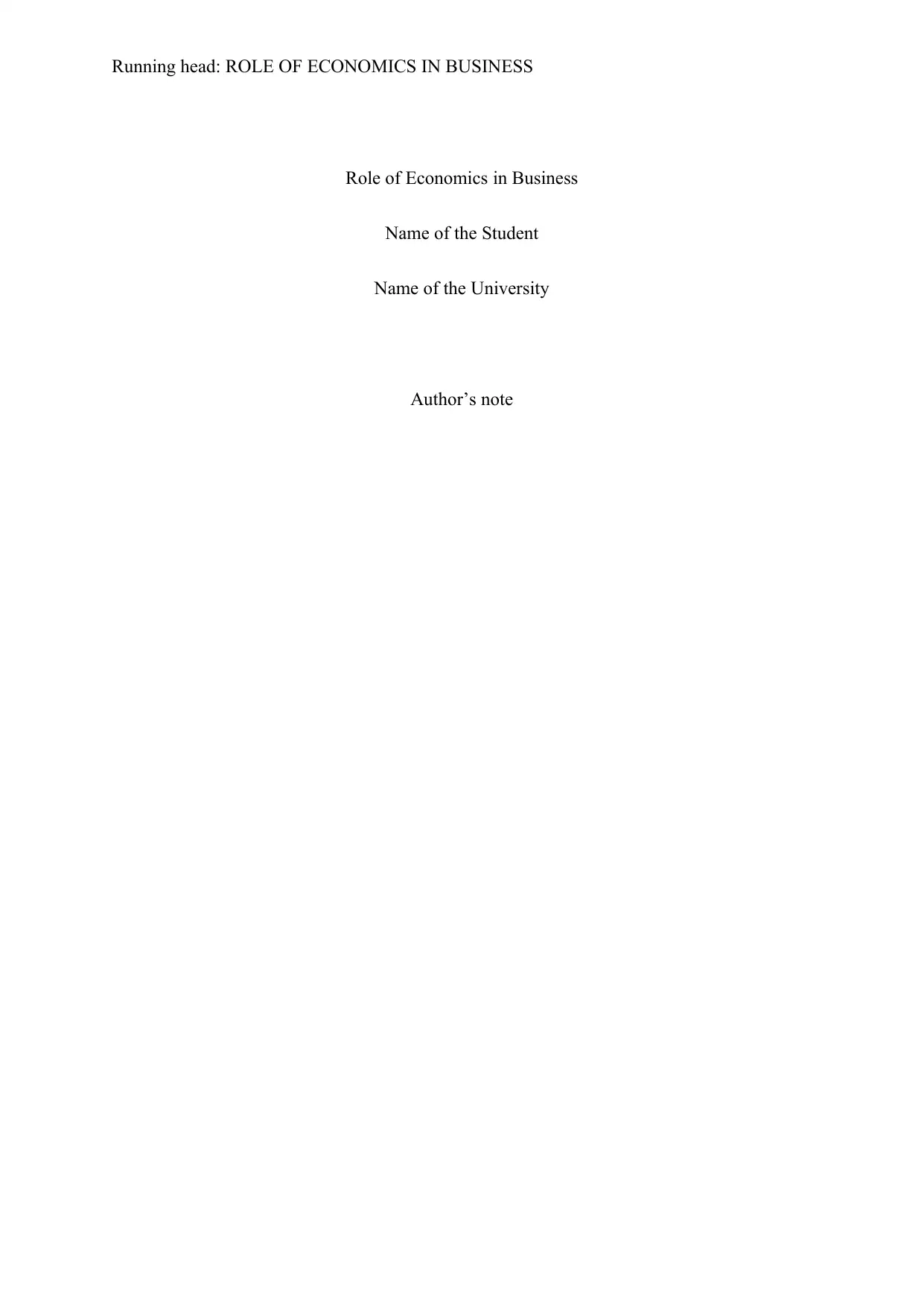
Running head: ROLE OF ECONOMICS IN BUSINESS
Role of Economics in Business
Name of the Student
Name of the University
Author’s note
Role of Economics in Business
Name of the Student
Name of the University
Author’s note
Paraphrase This Document
Need a fresh take? Get an instant paraphrase of this document with our AI Paraphraser
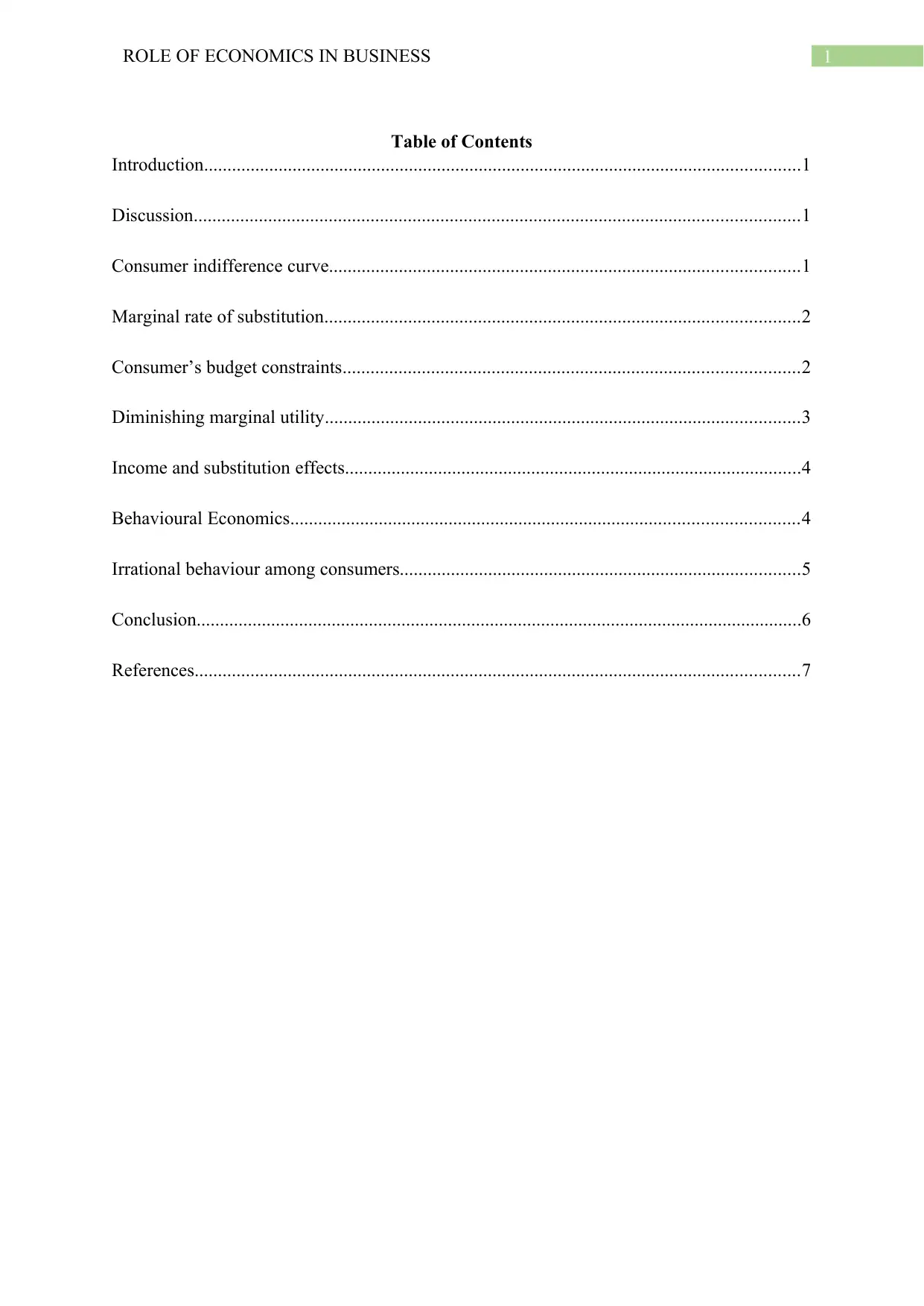
1ROLE OF ECONOMICS IN BUSINESS
Table of Contents
Introduction................................................................................................................................1
Discussion..................................................................................................................................1
Consumer indifference curve.....................................................................................................1
Marginal rate of substitution......................................................................................................2
Consumer’s budget constraints..................................................................................................2
Diminishing marginal utility......................................................................................................3
Income and substitution effects..................................................................................................4
Behavioural Economics.............................................................................................................4
Irrational behaviour among consumers......................................................................................5
Conclusion..................................................................................................................................6
References..................................................................................................................................7
Table of Contents
Introduction................................................................................................................................1
Discussion..................................................................................................................................1
Consumer indifference curve.....................................................................................................1
Marginal rate of substitution......................................................................................................2
Consumer’s budget constraints..................................................................................................2
Diminishing marginal utility......................................................................................................3
Income and substitution effects..................................................................................................4
Behavioural Economics.............................................................................................................4
Irrational behaviour among consumers......................................................................................5
Conclusion..................................................................................................................................6
References..................................................................................................................................7
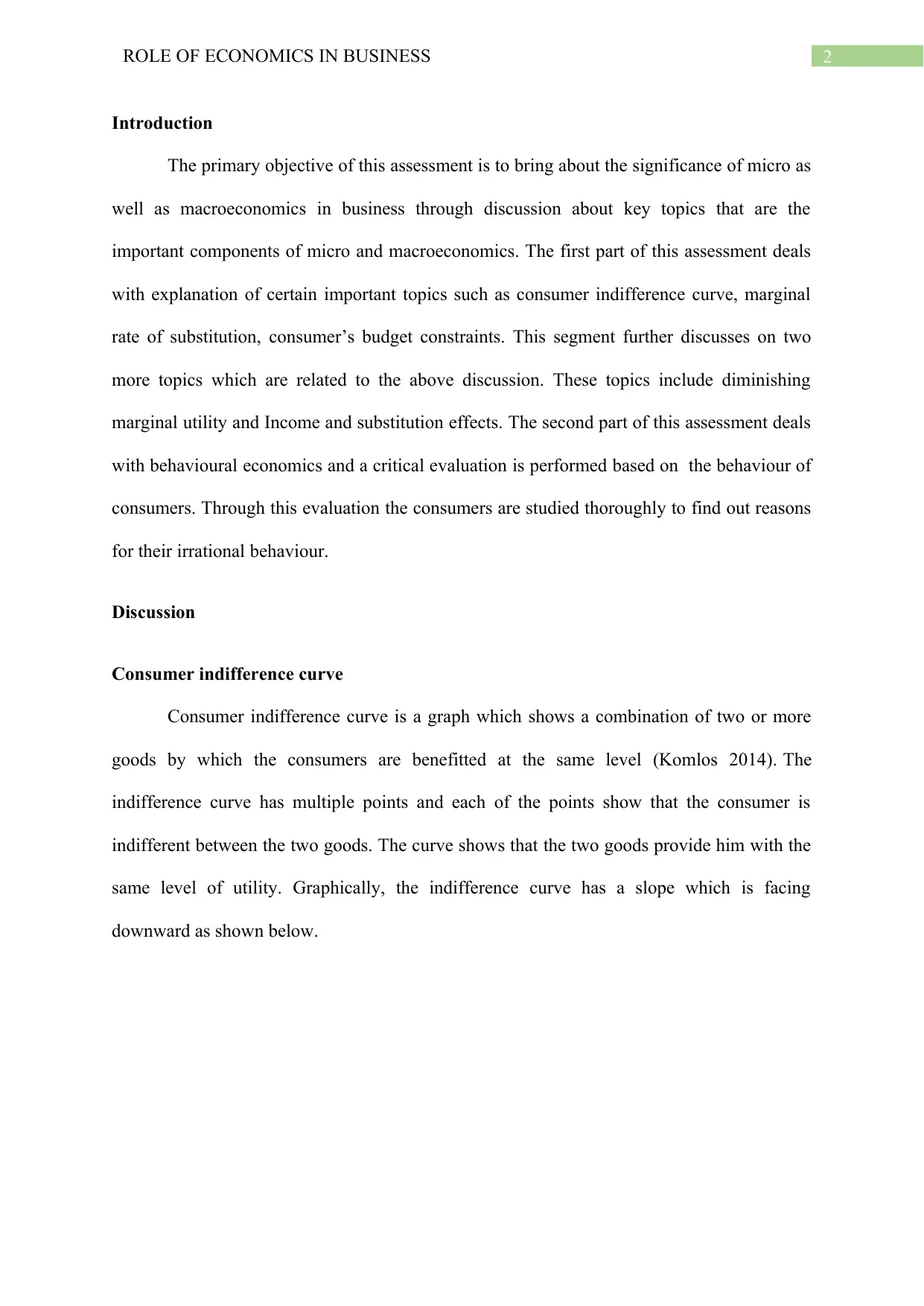
2ROLE OF ECONOMICS IN BUSINESS
Introduction
The primary objective of this assessment is to bring about the significance of micro as
well as macroeconomics in business through discussion about key topics that are the
important components of micro and macroeconomics. The first part of this assessment deals
with explanation of certain important topics such as consumer indifference curve, marginal
rate of substitution, consumer’s budget constraints. This segment further discusses on two
more topics which are related to the above discussion. These topics include diminishing
marginal utility and Income and substitution effects. The second part of this assessment deals
with behavioural economics and a critical evaluation is performed based on the behaviour of
consumers. Through this evaluation the consumers are studied thoroughly to find out reasons
for their irrational behaviour.
Discussion
Consumer indifference curve
Consumer indifference curve is a graph which shows a combination of two or more
goods by which the consumers are benefitted at the same level (Komlos 2014). The
indifference curve has multiple points and each of the points show that the consumer is
indifferent between the two goods. The curve shows that the two goods provide him with the
same level of utility. Graphically, the indifference curve has a slope which is facing
downward as shown below.
Introduction
The primary objective of this assessment is to bring about the significance of micro as
well as macroeconomics in business through discussion about key topics that are the
important components of micro and macroeconomics. The first part of this assessment deals
with explanation of certain important topics such as consumer indifference curve, marginal
rate of substitution, consumer’s budget constraints. This segment further discusses on two
more topics which are related to the above discussion. These topics include diminishing
marginal utility and Income and substitution effects. The second part of this assessment deals
with behavioural economics and a critical evaluation is performed based on the behaviour of
consumers. Through this evaluation the consumers are studied thoroughly to find out reasons
for their irrational behaviour.
Discussion
Consumer indifference curve
Consumer indifference curve is a graph which shows a combination of two or more
goods by which the consumers are benefitted at the same level (Komlos 2014). The
indifference curve has multiple points and each of the points show that the consumer is
indifferent between the two goods. The curve shows that the two goods provide him with the
same level of utility. Graphically, the indifference curve has a slope which is facing
downward as shown below.
⊘ This is a preview!⊘
Do you want full access?
Subscribe today to unlock all pages.

Trusted by 1+ million students worldwide
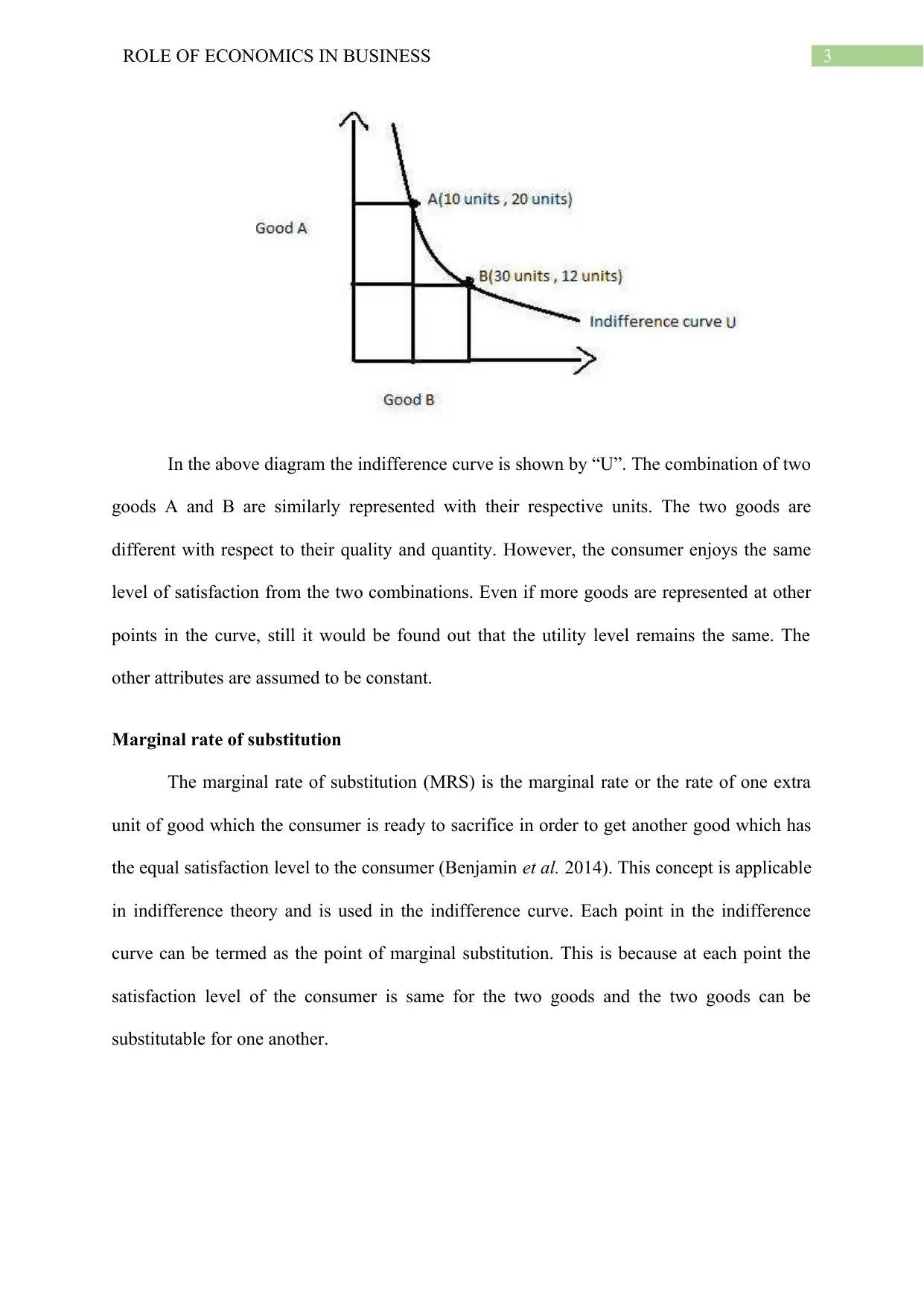
3ROLE OF ECONOMICS IN BUSINESS
In the above diagram the indifference curve is shown by “U”. The combination of two
goods A and B are similarly represented with their respective units. The two goods are
different with respect to their quality and quantity. However, the consumer enjoys the same
level of satisfaction from the two combinations. Even if more goods are represented at other
points in the curve, still it would be found out that the utility level remains the same. The
other attributes are assumed to be constant.
Marginal rate of substitution
The marginal rate of substitution (MRS) is the marginal rate or the rate of one extra
unit of good which the consumer is ready to sacrifice in order to get another good which has
the equal satisfaction level to the consumer (Benjamin et al. 2014). This concept is applicable
in indifference theory and is used in the indifference curve. Each point in the indifference
curve can be termed as the point of marginal substitution. This is because at each point the
satisfaction level of the consumer is same for the two goods and the two goods can be
substitutable for one another.
In the above diagram the indifference curve is shown by “U”. The combination of two
goods A and B are similarly represented with their respective units. The two goods are
different with respect to their quality and quantity. However, the consumer enjoys the same
level of satisfaction from the two combinations. Even if more goods are represented at other
points in the curve, still it would be found out that the utility level remains the same. The
other attributes are assumed to be constant.
Marginal rate of substitution
The marginal rate of substitution (MRS) is the marginal rate or the rate of one extra
unit of good which the consumer is ready to sacrifice in order to get another good which has
the equal satisfaction level to the consumer (Benjamin et al. 2014). This concept is applicable
in indifference theory and is used in the indifference curve. Each point in the indifference
curve can be termed as the point of marginal substitution. This is because at each point the
satisfaction level of the consumer is same for the two goods and the two goods can be
substitutable for one another.
Paraphrase This Document
Need a fresh take? Get an instant paraphrase of this document with our AI Paraphraser
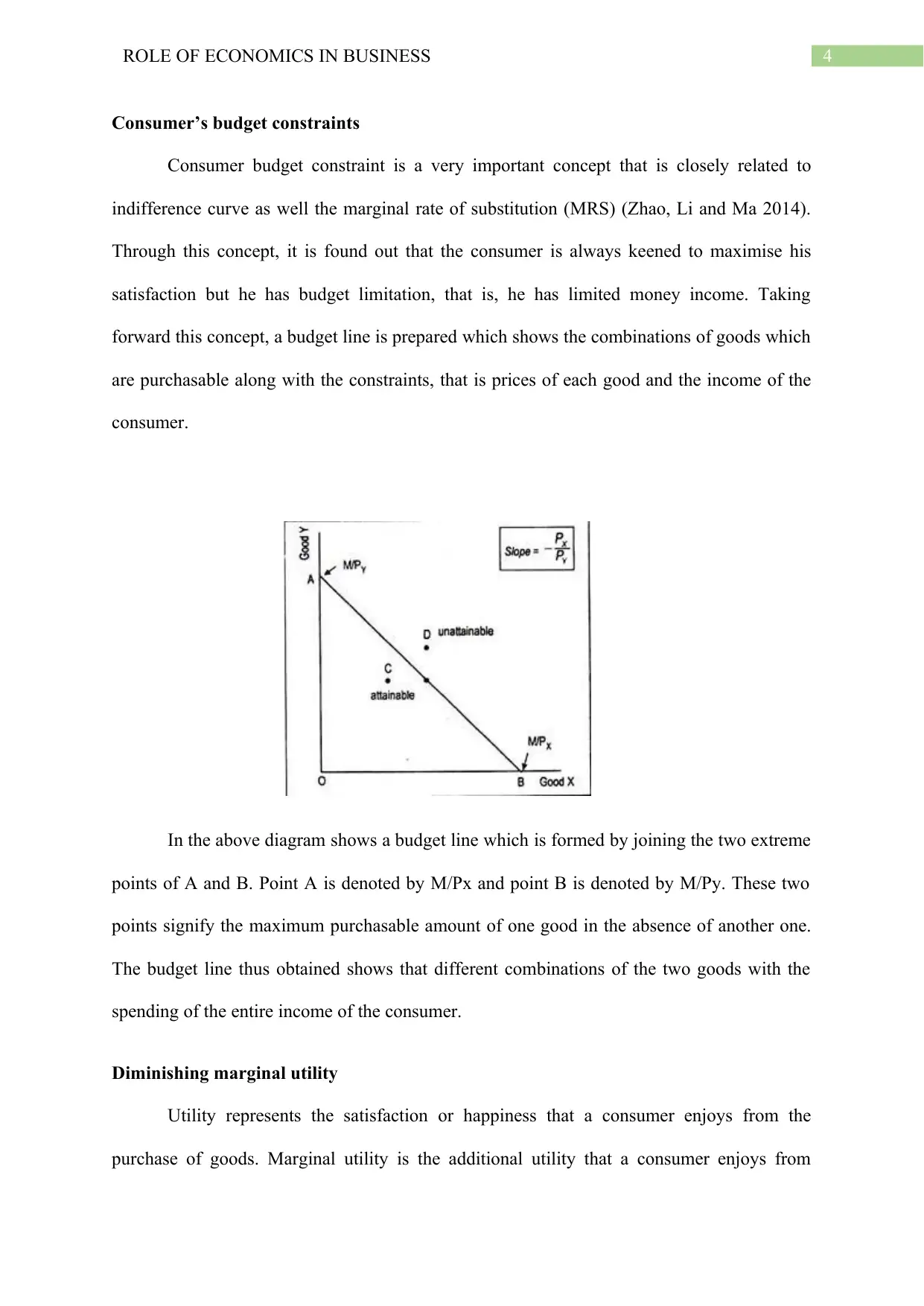
4ROLE OF ECONOMICS IN BUSINESS
Consumer’s budget constraints
Consumer budget constraint is a very important concept that is closely related to
indifference curve as well the marginal rate of substitution (MRS) (Zhao, Li and Ma 2014).
Through this concept, it is found out that the consumer is always keened to maximise his
satisfaction but he has budget limitation, that is, he has limited money income. Taking
forward this concept, a budget line is prepared which shows the combinations of goods which
are purchasable along with the constraints, that is prices of each good and the income of the
consumer.
In the above diagram shows a budget line which is formed by joining the two extreme
points of A and B. Point A is denoted by M/Px and point B is denoted by M/Py. These two
points signify the maximum purchasable amount of one good in the absence of another one.
The budget line thus obtained shows that different combinations of the two goods with the
spending of the entire income of the consumer.
Diminishing marginal utility
Utility represents the satisfaction or happiness that a consumer enjoys from the
purchase of goods. Marginal utility is the additional utility that a consumer enjoys from
Consumer’s budget constraints
Consumer budget constraint is a very important concept that is closely related to
indifference curve as well the marginal rate of substitution (MRS) (Zhao, Li and Ma 2014).
Through this concept, it is found out that the consumer is always keened to maximise his
satisfaction but he has budget limitation, that is, he has limited money income. Taking
forward this concept, a budget line is prepared which shows the combinations of goods which
are purchasable along with the constraints, that is prices of each good and the income of the
consumer.
In the above diagram shows a budget line which is formed by joining the two extreme
points of A and B. Point A is denoted by M/Px and point B is denoted by M/Py. These two
points signify the maximum purchasable amount of one good in the absence of another one.
The budget line thus obtained shows that different combinations of the two goods with the
spending of the entire income of the consumer.
Diminishing marginal utility
Utility represents the satisfaction or happiness that a consumer enjoys from the
purchase of goods. Marginal utility is the additional utility that a consumer enjoys from
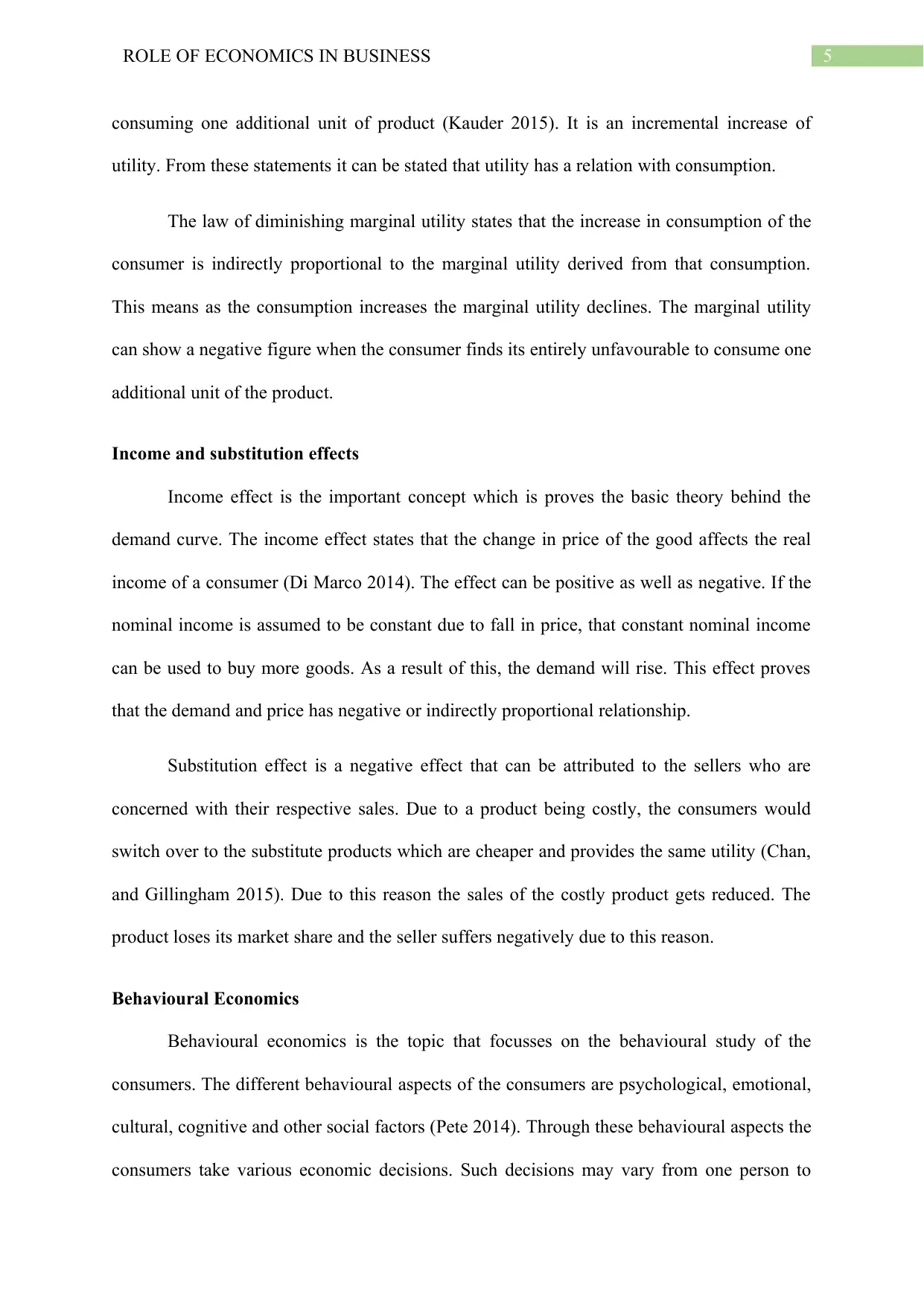
5ROLE OF ECONOMICS IN BUSINESS
consuming one additional unit of product (Kauder 2015). It is an incremental increase of
utility. From these statements it can be stated that utility has a relation with consumption.
The law of diminishing marginal utility states that the increase in consumption of the
consumer is indirectly proportional to the marginal utility derived from that consumption.
This means as the consumption increases the marginal utility declines. The marginal utility
can show a negative figure when the consumer finds its entirely unfavourable to consume one
additional unit of the product.
Income and substitution effects
Income effect is the important concept which is proves the basic theory behind the
demand curve. The income effect states that the change in price of the good affects the real
income of a consumer (Di Marco 2014). The effect can be positive as well as negative. If the
nominal income is assumed to be constant due to fall in price, that constant nominal income
can be used to buy more goods. As a result of this, the demand will rise. This effect proves
that the demand and price has negative or indirectly proportional relationship.
Substitution effect is a negative effect that can be attributed to the sellers who are
concerned with their respective sales. Due to a product being costly, the consumers would
switch over to the substitute products which are cheaper and provides the same utility (Chan,
and Gillingham 2015). Due to this reason the sales of the costly product gets reduced. The
product loses its market share and the seller suffers negatively due to this reason.
Behavioural Economics
Behavioural economics is the topic that focusses on the behavioural study of the
consumers. The different behavioural aspects of the consumers are psychological, emotional,
cultural, cognitive and other social factors (Pete 2014). Through these behavioural aspects the
consumers take various economic decisions. Such decisions may vary from one person to
consuming one additional unit of product (Kauder 2015). It is an incremental increase of
utility. From these statements it can be stated that utility has a relation with consumption.
The law of diminishing marginal utility states that the increase in consumption of the
consumer is indirectly proportional to the marginal utility derived from that consumption.
This means as the consumption increases the marginal utility declines. The marginal utility
can show a negative figure when the consumer finds its entirely unfavourable to consume one
additional unit of the product.
Income and substitution effects
Income effect is the important concept which is proves the basic theory behind the
demand curve. The income effect states that the change in price of the good affects the real
income of a consumer (Di Marco 2014). The effect can be positive as well as negative. If the
nominal income is assumed to be constant due to fall in price, that constant nominal income
can be used to buy more goods. As a result of this, the demand will rise. This effect proves
that the demand and price has negative or indirectly proportional relationship.
Substitution effect is a negative effect that can be attributed to the sellers who are
concerned with their respective sales. Due to a product being costly, the consumers would
switch over to the substitute products which are cheaper and provides the same utility (Chan,
and Gillingham 2015). Due to this reason the sales of the costly product gets reduced. The
product loses its market share and the seller suffers negatively due to this reason.
Behavioural Economics
Behavioural economics is the topic that focusses on the behavioural study of the
consumers. The different behavioural aspects of the consumers are psychological, emotional,
cultural, cognitive and other social factors (Pete 2014). Through these behavioural aspects the
consumers take various economic decisions. Such decisions may vary from one person to
⊘ This is a preview!⊘
Do you want full access?
Subscribe today to unlock all pages.

Trusted by 1+ million students worldwide
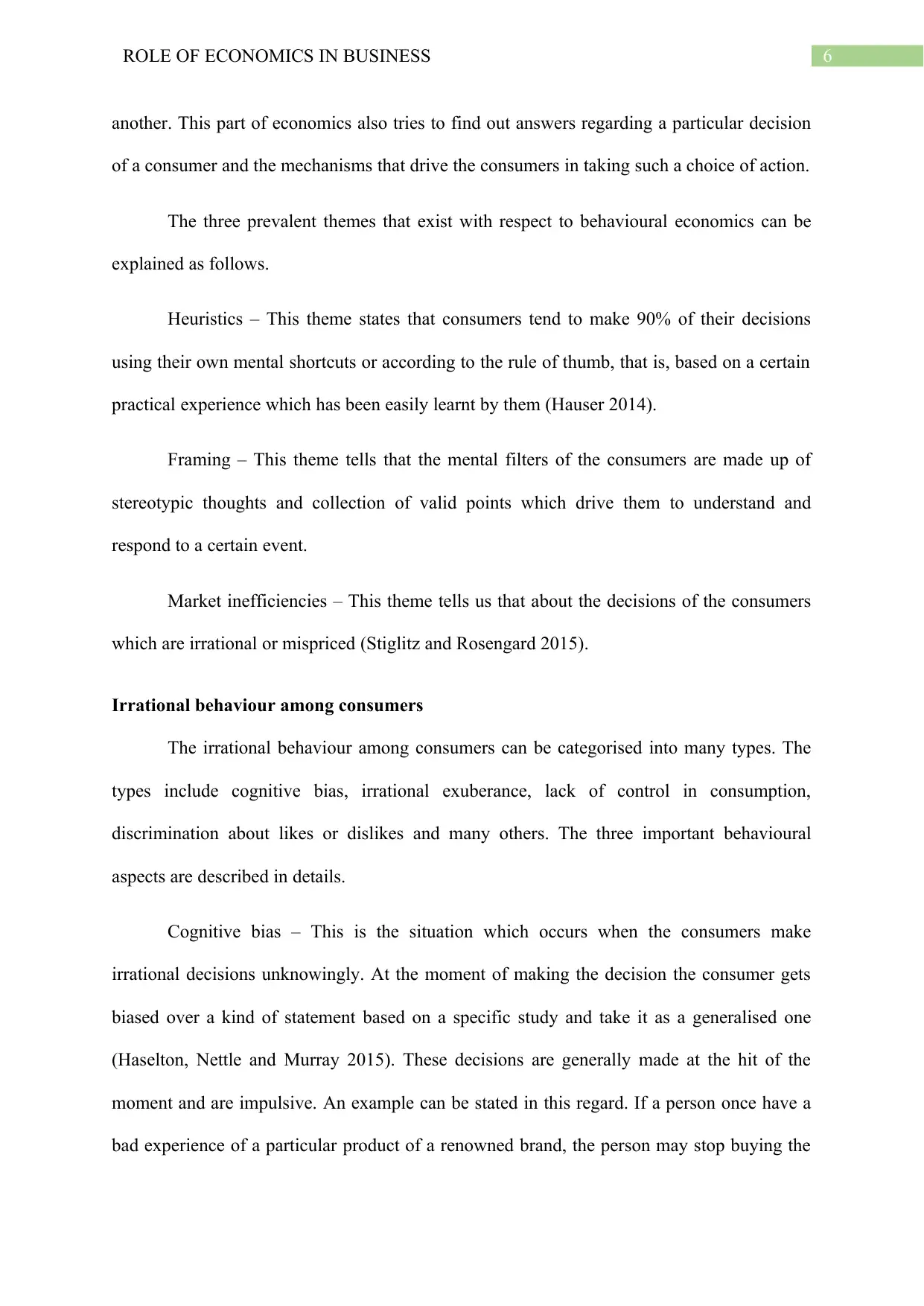
6ROLE OF ECONOMICS IN BUSINESS
another. This part of economics also tries to find out answers regarding a particular decision
of a consumer and the mechanisms that drive the consumers in taking such a choice of action.
The three prevalent themes that exist with respect to behavioural economics can be
explained as follows.
Heuristics – This theme states that consumers tend to make 90% of their decisions
using their own mental shortcuts or according to the rule of thumb, that is, based on a certain
practical experience which has been easily learnt by them (Hauser 2014).
Framing – This theme tells that the mental filters of the consumers are made up of
stereotypic thoughts and collection of valid points which drive them to understand and
respond to a certain event.
Market inefficiencies – This theme tells us that about the decisions of the consumers
which are irrational or mispriced (Stiglitz and Rosengard 2015).
Irrational behaviour among consumers
The irrational behaviour among consumers can be categorised into many types. The
types include cognitive bias, irrational exuberance, lack of control in consumption,
discrimination about likes or dislikes and many others. The three important behavioural
aspects are described in details.
Cognitive bias – This is the situation which occurs when the consumers make
irrational decisions unknowingly. At the moment of making the decision the consumer gets
biased over a kind of statement based on a specific study and take it as a generalised one
(Haselton, Nettle and Murray 2015). These decisions are generally made at the hit of the
moment and are impulsive. An example can be stated in this regard. If a person once have a
bad experience of a particular product of a renowned brand, the person may stop buying the
another. This part of economics also tries to find out answers regarding a particular decision
of a consumer and the mechanisms that drive the consumers in taking such a choice of action.
The three prevalent themes that exist with respect to behavioural economics can be
explained as follows.
Heuristics – This theme states that consumers tend to make 90% of their decisions
using their own mental shortcuts or according to the rule of thumb, that is, based on a certain
practical experience which has been easily learnt by them (Hauser 2014).
Framing – This theme tells that the mental filters of the consumers are made up of
stereotypic thoughts and collection of valid points which drive them to understand and
respond to a certain event.
Market inefficiencies – This theme tells us that about the decisions of the consumers
which are irrational or mispriced (Stiglitz and Rosengard 2015).
Irrational behaviour among consumers
The irrational behaviour among consumers can be categorised into many types. The
types include cognitive bias, irrational exuberance, lack of control in consumption,
discrimination about likes or dislikes and many others. The three important behavioural
aspects are described in details.
Cognitive bias – This is the situation which occurs when the consumers make
irrational decisions unknowingly. At the moment of making the decision the consumer gets
biased over a kind of statement based on a specific study and take it as a generalised one
(Haselton, Nettle and Murray 2015). These decisions are generally made at the hit of the
moment and are impulsive. An example can be stated in this regard. If a person once have a
bad experience of a particular product of a renowned brand, the person may stop buying the
Paraphrase This Document
Need a fresh take? Get an instant paraphrase of this document with our AI Paraphraser
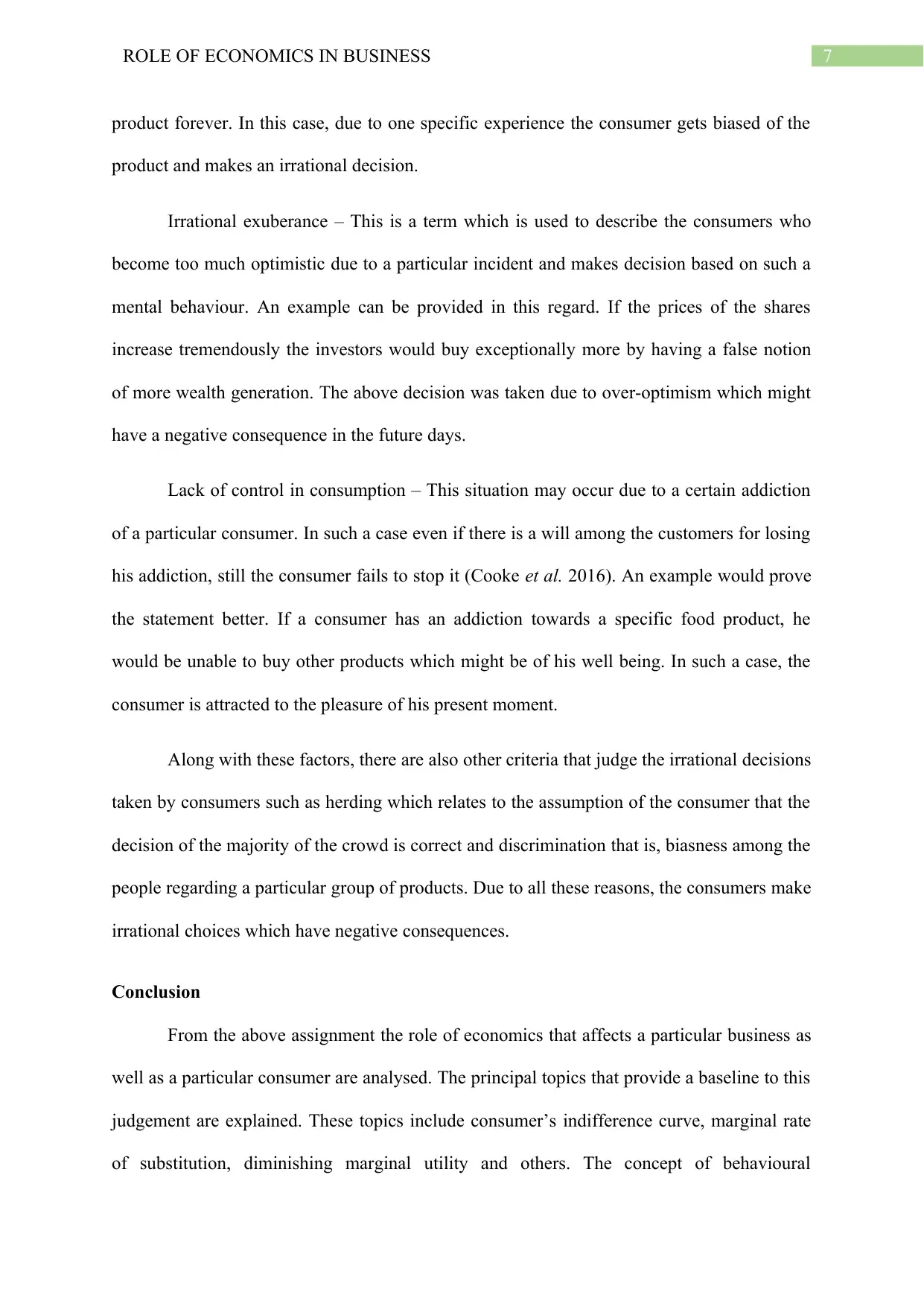
7ROLE OF ECONOMICS IN BUSINESS
product forever. In this case, due to one specific experience the consumer gets biased of the
product and makes an irrational decision.
Irrational exuberance – This is a term which is used to describe the consumers who
become too much optimistic due to a particular incident and makes decision based on such a
mental behaviour. An example can be provided in this regard. If the prices of the shares
increase tremendously the investors would buy exceptionally more by having a false notion
of more wealth generation. The above decision was taken due to over-optimism which might
have a negative consequence in the future days.
Lack of control in consumption – This situation may occur due to a certain addiction
of a particular consumer. In such a case even if there is a will among the customers for losing
his addiction, still the consumer fails to stop it (Cooke et al. 2016). An example would prove
the statement better. If a consumer has an addiction towards a specific food product, he
would be unable to buy other products which might be of his well being. In such a case, the
consumer is attracted to the pleasure of his present moment.
Along with these factors, there are also other criteria that judge the irrational decisions
taken by consumers such as herding which relates to the assumption of the consumer that the
decision of the majority of the crowd is correct and discrimination that is, biasness among the
people regarding a particular group of products. Due to all these reasons, the consumers make
irrational choices which have negative consequences.
Conclusion
From the above assignment the role of economics that affects a particular business as
well as a particular consumer are analysed. The principal topics that provide a baseline to this
judgement are explained. These topics include consumer’s indifference curve, marginal rate
of substitution, diminishing marginal utility and others. The concept of behavioural
product forever. In this case, due to one specific experience the consumer gets biased of the
product and makes an irrational decision.
Irrational exuberance – This is a term which is used to describe the consumers who
become too much optimistic due to a particular incident and makes decision based on such a
mental behaviour. An example can be provided in this regard. If the prices of the shares
increase tremendously the investors would buy exceptionally more by having a false notion
of more wealth generation. The above decision was taken due to over-optimism which might
have a negative consequence in the future days.
Lack of control in consumption – This situation may occur due to a certain addiction
of a particular consumer. In such a case even if there is a will among the customers for losing
his addiction, still the consumer fails to stop it (Cooke et al. 2016). An example would prove
the statement better. If a consumer has an addiction towards a specific food product, he
would be unable to buy other products which might be of his well being. In such a case, the
consumer is attracted to the pleasure of his present moment.
Along with these factors, there are also other criteria that judge the irrational decisions
taken by consumers such as herding which relates to the assumption of the consumer that the
decision of the majority of the crowd is correct and discrimination that is, biasness among the
people regarding a particular group of products. Due to all these reasons, the consumers make
irrational choices which have negative consequences.
Conclusion
From the above assignment the role of economics that affects a particular business as
well as a particular consumer are analysed. The principal topics that provide a baseline to this
judgement are explained. These topics include consumer’s indifference curve, marginal rate
of substitution, diminishing marginal utility and others. The concept of behavioural
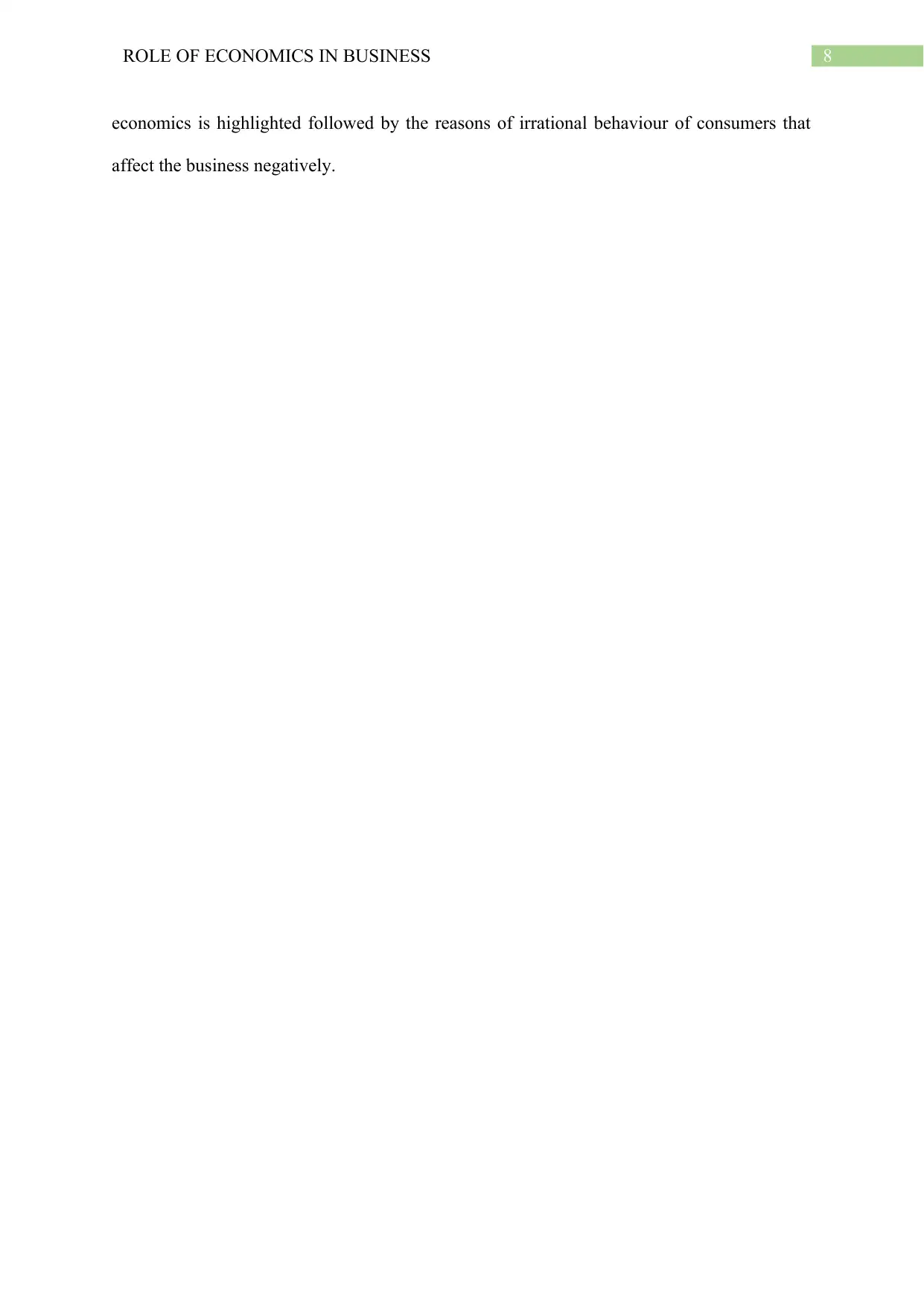
8ROLE OF ECONOMICS IN BUSINESS
economics is highlighted followed by the reasons of irrational behaviour of consumers that
affect the business negatively.
economics is highlighted followed by the reasons of irrational behaviour of consumers that
affect the business negatively.
⊘ This is a preview!⊘
Do you want full access?
Subscribe today to unlock all pages.

Trusted by 1+ million students worldwide
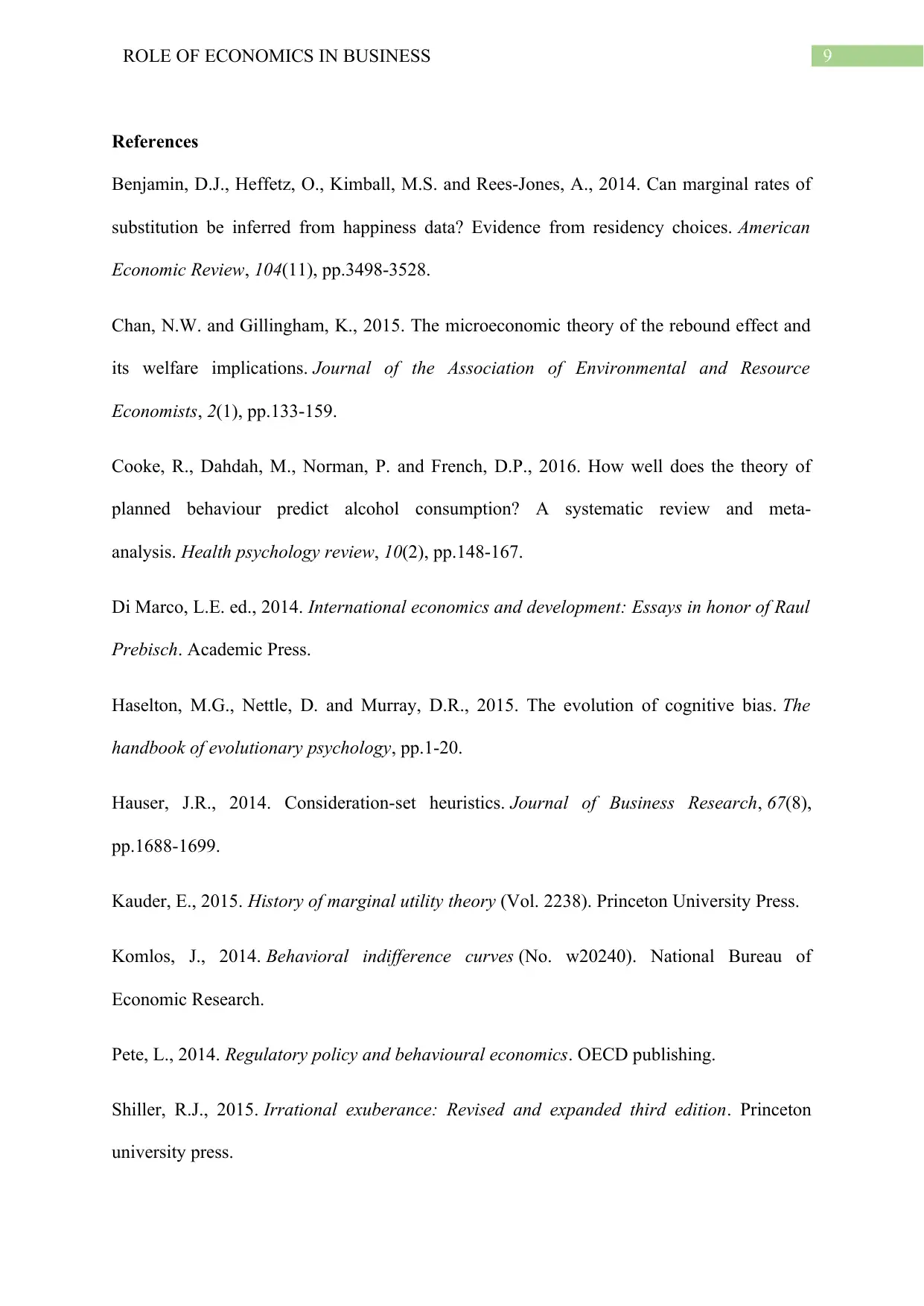
9ROLE OF ECONOMICS IN BUSINESS
References
Benjamin, D.J., Heffetz, O., Kimball, M.S. and Rees-Jones, A., 2014. Can marginal rates of
substitution be inferred from happiness data? Evidence from residency choices. American
Economic Review, 104(11), pp.3498-3528.
Chan, N.W. and Gillingham, K., 2015. The microeconomic theory of the rebound effect and
its welfare implications. Journal of the Association of Environmental and Resource
Economists, 2(1), pp.133-159.
Cooke, R., Dahdah, M., Norman, P. and French, D.P., 2016. How well does the theory of
planned behaviour predict alcohol consumption? A systematic review and meta-
analysis. Health psychology review, 10(2), pp.148-167.
Di Marco, L.E. ed., 2014. International economics and development: Essays in honor of Raul
Prebisch. Academic Press.
Haselton, M.G., Nettle, D. and Murray, D.R., 2015. The evolution of cognitive bias. The
handbook of evolutionary psychology, pp.1-20.
Hauser, J.R., 2014. Consideration-set heuristics. Journal of Business Research, 67(8),
pp.1688-1699.
Kauder, E., 2015. History of marginal utility theory (Vol. 2238). Princeton University Press.
Komlos, J., 2014. Behavioral indifference curves (No. w20240). National Bureau of
Economic Research.
Pete, L., 2014. Regulatory policy and behavioural economics. OECD publishing.
Shiller, R.J., 2015. Irrational exuberance: Revised and expanded third edition. Princeton
university press.
References
Benjamin, D.J., Heffetz, O., Kimball, M.S. and Rees-Jones, A., 2014. Can marginal rates of
substitution be inferred from happiness data? Evidence from residency choices. American
Economic Review, 104(11), pp.3498-3528.
Chan, N.W. and Gillingham, K., 2015. The microeconomic theory of the rebound effect and
its welfare implications. Journal of the Association of Environmental and Resource
Economists, 2(1), pp.133-159.
Cooke, R., Dahdah, M., Norman, P. and French, D.P., 2016. How well does the theory of
planned behaviour predict alcohol consumption? A systematic review and meta-
analysis. Health psychology review, 10(2), pp.148-167.
Di Marco, L.E. ed., 2014. International economics and development: Essays in honor of Raul
Prebisch. Academic Press.
Haselton, M.G., Nettle, D. and Murray, D.R., 2015. The evolution of cognitive bias. The
handbook of evolutionary psychology, pp.1-20.
Hauser, J.R., 2014. Consideration-set heuristics. Journal of Business Research, 67(8),
pp.1688-1699.
Kauder, E., 2015. History of marginal utility theory (Vol. 2238). Princeton University Press.
Komlos, J., 2014. Behavioral indifference curves (No. w20240). National Bureau of
Economic Research.
Pete, L., 2014. Regulatory policy and behavioural economics. OECD publishing.
Shiller, R.J., 2015. Irrational exuberance: Revised and expanded third edition. Princeton
university press.
Paraphrase This Document
Need a fresh take? Get an instant paraphrase of this document with our AI Paraphraser
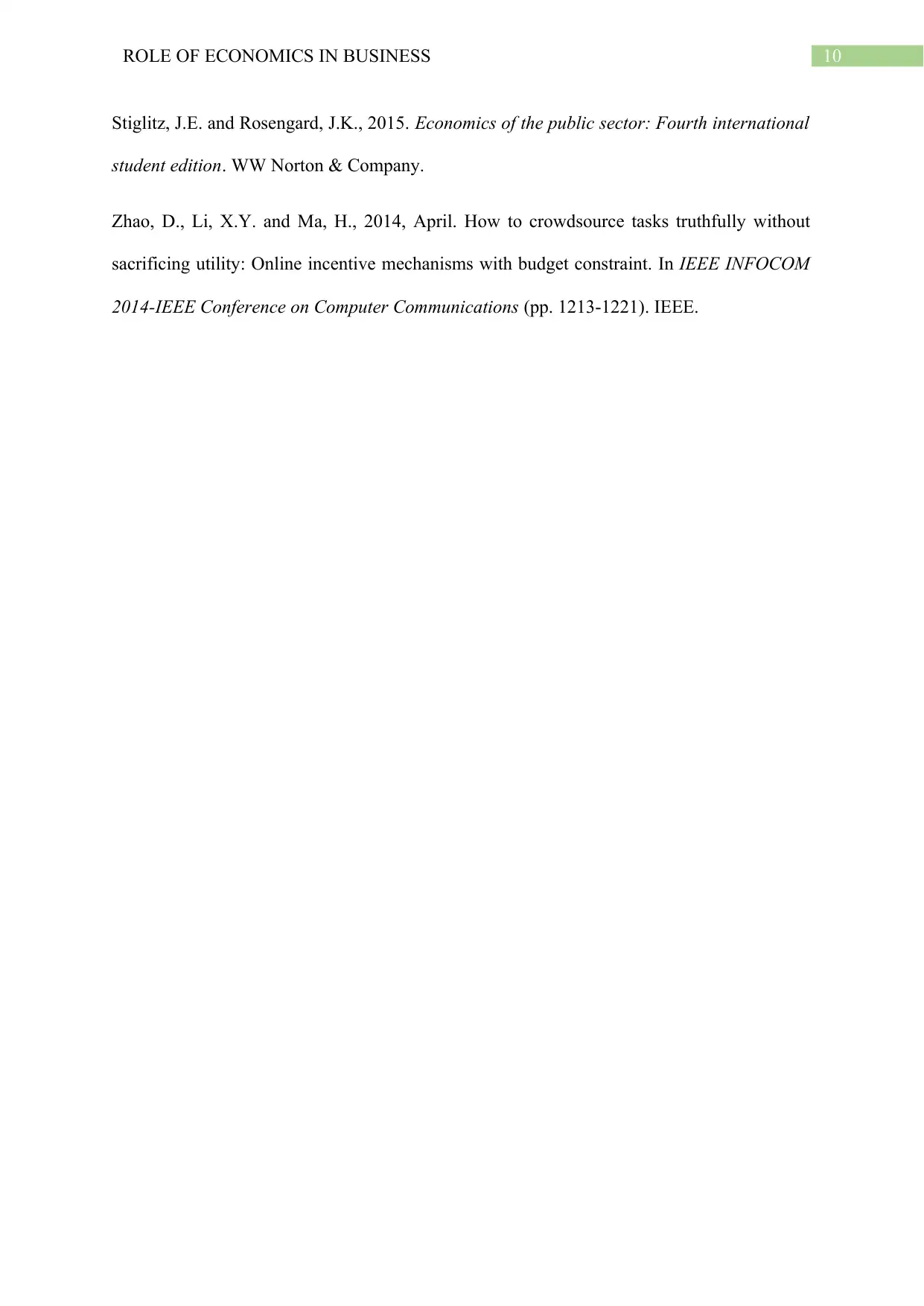
10ROLE OF ECONOMICS IN BUSINESS
Stiglitz, J.E. and Rosengard, J.K., 2015. Economics of the public sector: Fourth international
student edition. WW Norton & Company.
Zhao, D., Li, X.Y. and Ma, H., 2014, April. How to crowdsource tasks truthfully without
sacrificing utility: Online incentive mechanisms with budget constraint. In IEEE INFOCOM
2014-IEEE Conference on Computer Communications (pp. 1213-1221). IEEE.
Stiglitz, J.E. and Rosengard, J.K., 2015. Economics of the public sector: Fourth international
student edition. WW Norton & Company.
Zhao, D., Li, X.Y. and Ma, H., 2014, April. How to crowdsource tasks truthfully without
sacrificing utility: Online incentive mechanisms with budget constraint. In IEEE INFOCOM
2014-IEEE Conference on Computer Communications (pp. 1213-1221). IEEE.
1 out of 11
Related Documents
Your All-in-One AI-Powered Toolkit for Academic Success.
+13062052269
info@desklib.com
Available 24*7 on WhatsApp / Email
![[object Object]](/_next/static/media/star-bottom.7253800d.svg)
Unlock your academic potential
Copyright © 2020–2025 A2Z Services. All Rights Reserved. Developed and managed by ZUCOL.




